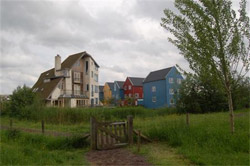 |
 |
Waterzoning -and ecological plan of Eva/Lanxmeer
Especially the subterranean structure has been used for the overall plan, the water zoning- and ecological plan. Besides of that general principles of Permaculture affected the spatial structure of the plan, especially the green zoning. Environmental measures include use of sustainable building materials, a closed water circuit, an integral water management system, organic food production.,and a biogas production facility. Precipitation from roofs is collected in ponds, water from the street surface infiltrates into wide infiltration trenches, and restored old riverbeds provide additional water storage capacity. A closed greenhouse, designed as a four storey high double skin façade of the semi-public building, with integrated wastewater treatment for parts of the wastewater flows based on the Living Machine concept is added for educational purposes. In this vertical green house with ‘hanging gardens’ heat (and water) recovery and use of the surplus CO2 of the biogas plant takes place, together with heat/cold storage in an underlying aquifer. The concept is called ‘Sustainable Implant’.
 There is a gradual transition from private-, semi-private-, and public space towards a more natural landscape in the protected zone of the Water Company.
Together these green zones form an environment that displays the diversity and resilience of natural ecosystems. Eva/Lanxmeer can be called the ‘Park of the 21st century’.
There is a gradual transition from private-, semi-private-, and public space towards a more natural landscape in the protected zone of the Water Company.
Together these green zones form an environment that displays the diversity and resilience of natural ecosystems. Eva/Lanxmeer can be called the ‘Park of the 21st century’.
Participation of inhabitants
The new housing estate has been established through the joint effort of the Dutch Education, Information and Advice foundation (EVA) and the municipality of Culemborg. The inhabitants took active part in workshops and in the overall planning process. Lanxmeer is a national and international reference in terms of sustainable town planning and social development.
|
|



